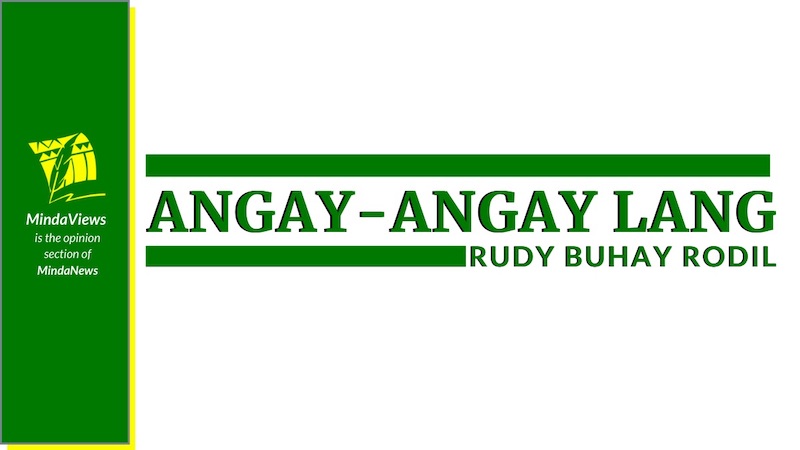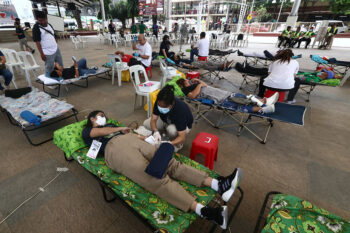
Part 2 of 7: What is the Expected RCC-MM Output?
Rudy Buhay Rodil
ILIGAN CITY (MindaNews / 7 Oct) – Beyond the phrase “final report,” Republic Act 6649 said nothing more about the expected output of the Regional Consultative Commission for Muslim Mindanao (RCC-MM). During the organizational phase, some time was spent figuring out what this output might be.
The guiding question was what would be the most worthwhile assistance of the Commission to Congress. The answer agreed upon: a draft organic act. And the reasons bear recalling here.
The Commissioners are all long-time residents in the region; they have lived with the problem at hand and are therefore expected to have a feel of the situation better than any grouping. In addition, they would be conducting public consultations at both district and regional levels as prescribed by the law.
In the months of May and June, the individual Commissioners went into the consultation process without any agreed format at the Commission level. Neither specific methods nor specific goals were arrived at.
It was clear enough what district Commissioners would be doing, but the same was not true with Commissioners-at-Large. Thus, consultation methods varied from one Commissioner to another.
There were those who went from one barangay to the next or to as many municipalities within their district; there were those who confined themselves to the specifics of their committees and consulted only with relevant groups; there were those who went to several districts; there were those who limited themselves to information drives through radio, and there were those who stayed at home and merely waited for constituents to come.
Needless to say the results were as varied as the methodology. Still, on the whole, the consultation did produce substantial input in a manner that is not easy to quantify. Insights derived from people’s comments and translated into concrete proposals cannot be reduced to mathematical terms.
In the month of July and in the first week of August, regional level consultations were conducted in Puerto Princesa City, Zamboanga City, Marawi City, Cotabato City and General Santos City.
Easily the most controversial, meaning touchy issue in almost all the consultations was the name of the autonomy. Non-Muslims generally reacted with alarm over “Muslim Mindanao.”
This was taken as proof of their suspicion that the Muslims were out to dominate the government of the autonomy. Surprisingly, even Muslims (some being members of the MNLF) sensed the divisive effect of this name; some of the latter in Sulu even commented that the introduction of the phrase was a deliberate ploy on the part of the central government precisely to sabotage the struggle of the Bangsamoro for self-determination.
But because the phrase was claimed to be enshrined in the 1987 Constitution, and in reaction to negative feedbacks, advocates and defenders of the name shot back that proposals to delete it were in effect resuming the colonial policy of annihilation, except that now it took the form of deletion.
And so, as early as May and June, the Commission was deeply aware of the temper of the people.
Those opposed to the name and were automatically for non-inclusion of their respective places from the territory of the autonomy were the Christian-dominated provinces and cities, as follows: Davao del Sur, South Cotabato, Sultan Kudarat, Cotabato, Lanao del Norte, Zamboanga del Norte, Zamboanga del Sur, Palawan, General Santos City, Cotabato City, Iligan City, Pagadian City, Dapitan City, Dipolog City, Puerto Princesa City and Zamboanga City.
Generally in favor of inclusion in the autonomy were the Muslim dominated provinces of Maguindanao, Lanao del Sur, Basilan, Sulu, Tawi-Tawi and Marawi City.
Such a result reflected the findings of the survey-study shared earlier by Dr. Marilou Costello.
Not surprisingly, the issue of the name became the dominating controversy in the entire Commission and remained unresolved until the last day of the plenary deliberations.
For those who were members of the Committee on Preamble, Regional Territory and Declaration of Principles, of which I was one, being in the eye of the storm for four months was not exactly a pleasant experience. The turbulence that raged outside was intensely replicated within the Committee itself.
August to September, especially the last 11 days, were plenary session days. On the evening of the last, September 30th, the Commission stopped the clock at exactly 11:53 PM and went on sine die session.
At around 2:00 AM, the chairman of the Committee on General and Transitory Provisions walked out unexpectedly, and shortly thereafter, after a brief recess and consultation, there was a motion for adjournment, and the Chairman declared the session indefinitely adjourned.
What was the status of the envisioned draft organic act at the time of adjournment? The following were to-be-accomplished:
1) For completion of second reading for:
a. preamble, title, name, territory and declaration of principles;
b. administrative organization of the government structure; and
c. general and transitory provisions.
2) For third reading for the entire draft organic act.
The abrupt ending which was triggered by the walk out of a Commissioner from Zamboanga City erased all possibilities of any other decision. As soon as the adjournment was declared, authority for the Commission to deliberate as a body ceased altogether.
There was no decision, for instance, that whatever the Commission accomplished ought to be called a draft organic act.
Tomorrow: Part 3: Value of the RCC-MM as a Political Process
[Si Prof. Rudy Buhay Rodil ay aktibong historyan ng Mindanao, tagapasulong ng kalinaw (Bisaya sa kapayapaan). Kilala siyang espesyalista sa paghusay ng mga gusot sa Mindanao-Sulu. Naging Komisyoner noon ng Regional Consultative Commision sa siyang nagbuo ng draft organic law ng Autonomous Region in Muslim Mindanao noong 1988. Dalawang beses siyang naging miyembro ng GRP Peace Negotiating Panel. 1993-1996, pakikipag-usap sa Moro National Liberation (MNLF), at noong 2004-2008 sa pakikipag-negosasyon sa Moro Islamic Liberation Front (MILF). Naging visiting propesor sa Hiroshima University, Oktubre-Disyembre 2011. Nagretiro noong Oktubre 2007.]







